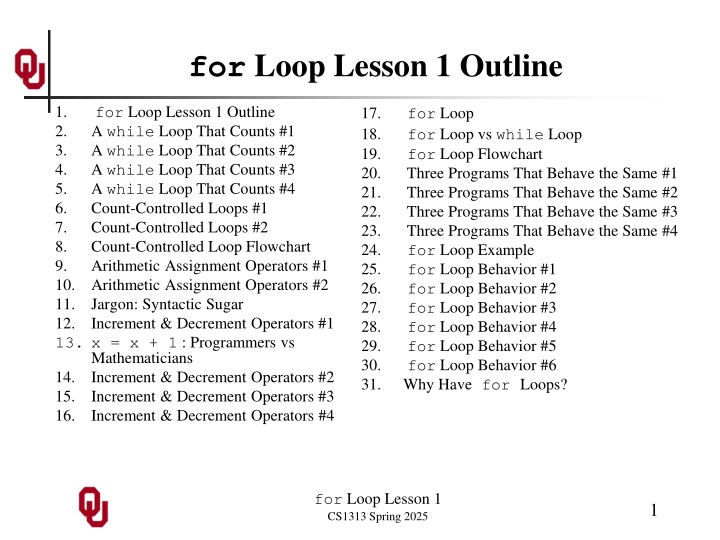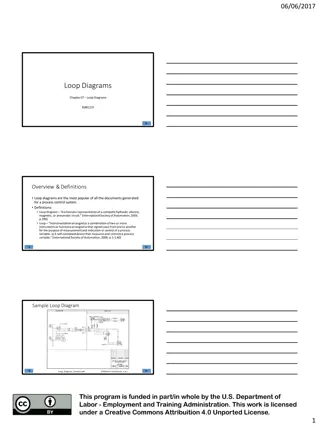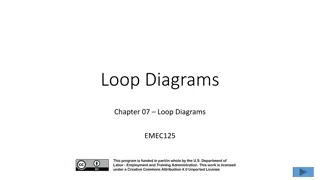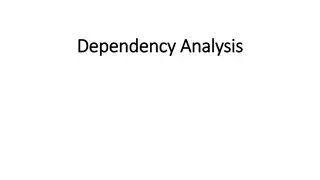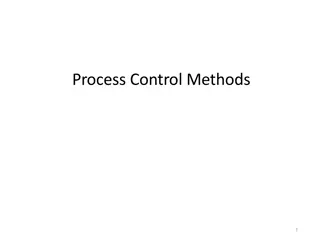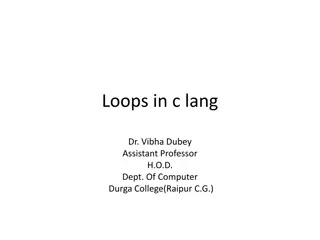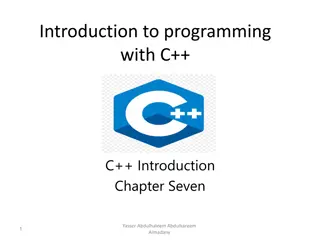For Loop in Programming
In this lesson, you will delve into the intricacies of for loops in programming, comparing the perspectives of programmers and mathematicians. You'll explore increment and decrement operators, count-controlled loops, arithmetic assignment operators, and the difference between for loops and while loops. Through examples and explanations, you'll gain a comprehensive understanding of how for loops work and why they are essential in programming. The lesson covers concepts such as loop flowcharts, behavior patterns, and practical applications. Engage with the content to enhance your coding skills and grasp the power of for loops in shaping program execution.
Download Presentation

Please find below an Image/Link to download the presentation.
The content on the website is provided AS IS for your information and personal use only. It may not be sold, licensed, or shared on other websites without obtaining consent from the author.If you encounter any issues during the download, it is possible that the publisher has removed the file from their server.
You are allowed to download the files provided on this website for personal or commercial use, subject to the condition that they are used lawfully. All files are the property of their respective owners.
The content on the website is provided AS IS for your information and personal use only. It may not be sold, licensed, or shared on other websites without obtaining consent from the author.
E N D
Presentation Transcript
for Loop Lesson 1 Outline 1. 2. 3. 4. 5. 6. 7. 8. 9. 10. 11. 12. 13. x = x + 1 : Programmers vs Mathematicians 14. Increment & Decrement Operators #2 15. Increment & Decrement Operators #3 16. Increment & Decrement Operators #4 for Loop Lesson 1 Outline A while Loop That Counts #1 A while Loop That Counts #2 A while Loop That Counts #3 A while Loop That Counts #4 Count-Controlled Loops #1 Count-Controlled Loops #2 Count-Controlled Loop Flowchart Arithmetic Assignment Operators #1 Arithmetic Assignment Operators #2 Jargon: Syntactic Sugar Increment & Decrement Operators #1 17. 18. 19. 20. 21. 22. 23. 24. 25. 26. 27. 28. 29. 30. 31. for Loop for Loop vs while Loop for Loop Flowchart Three Programs That Behave the Same #1 Three Programs That Behave the Same #2 Three Programs That Behave the Same #3 Three Programs That Behave the Same #4 for Loop Example for Loop Behavior #1 for Loop Behavior #2 for Loop Behavior #3 for Loop Behavior #4 for Loop Behavior #5 for Loop Behavior #6 Why Have for Loops? for Loop Lesson 1 CS1313 Spring 2025 1
A while Loop That Counts #1 #include <stdio.h> #include <stdlib.h> int main () { /* main */ const int initial_sum = 0; const int increment = 1; const int program_success_code = 0; const int program_failure_code = -1; int initial_value, final_value; int count; int sum; for Loop Lesson 1 CS1313 Spring 2025 2
A while Loop That Counts #2 printf("What value would you like to "); printf("start counting at?\n"); scanf("%d", &initial_value); printf("What value would you like to "); printf("stop counting at,\n"); printf(" which must be greater than "); printf("or equal to %d?\n", initial_value); scanf("%d", &final_value); if (final_value < initial_value) { printf("ERROR: the final value %d is less\n", final_value); printf(" than the initial value %d.\n", initial_value); exit(program_failure_code); } /* if (final_value < initial_value) */ for Loop Lesson 1 CS1313 Spring 2025 3
A while Loop That Counts #3 sum = initial_sum; count = initial_value; while (count <= final_value) { sum = sum + count; count = count + increment; } /* while (count <= final_value) */ printf("The sum of the integers from"); printf(" %d through %d is %d.\n", initial_value, final_value, sum); return program_success_code; } /* main */ for Loop Lesson 1 CS1313 Spring 2025 4
A while Loop That Counts #4 % gcc -o whilecount whilecount.c % whilecount What value would you like to start counting at? 1 What value would you like to stop counting at, which must be greater than or equal to 1? 0 ERROR: the final value 0 is less than the initial value 1. % whilecount What value would you like to start counting at? 1 What value would you like to stop counting at, which must be greater than or equal to 1? 5 The sum of the integers from 1 through 5 is 15. for Loop Lesson 1 CS1313 Spring 2025 5
Count-Controlled Loops #1 On the previous slide, we saw a case of a loop that: executes a specific number of iterations, by using a counter variable, which is initialized to a particular initial value and is incremented(increased by 1) at the end of each iteration of the loop, until it goes beyond a particular final value: sum = initial_sum; count = initial_value; while (count <= final_value) { sum = sum + count; count = count + increment; } /* while (count <= final_value) */ for Loop Lesson 1 CS1313 Spring 2025 6
Count-Controlled Loops #2 sum = initial_sum; count = initial_value; while (count <= final_value) { sum = sum + count; count = count + increment; } /* while (count <= final_value) */ We call this kind of loop a count-controlled loop. If we express a count-controlled loop as a while loop, then the general form is: counter = initial_value; while (counter<= final value) { statement1; statement2; ... counter = counter + 1; } /* while (counter<= final value) */ for Loop Lesson 1 CS1313 Spring 2025 7
Count-Controlled Loop Flowchart counter = initial_value; while (counter<= final value) { statement1; statement2; ... counter = counter+ 1; } /* while (counter<= final value) */ statement_after; for Loop Lesson 1 CS1313 Spring 2025 8
Arithmetic Assignment Operators #1 Some while back, we saw the following: x = x + y; We learned that this statement increases the value of x by y. That is, the statement takes the old value of x, adds y to it, then assigns the result of this addition to x. This kind of statement is so common that the C language has a special operator for it, called the addition assignment operator: x += y; Note that the two statements above behave identically. for Loop Lesson 1 CS1313 Spring 2025 9
Arithmetic Assignment Operators #2 C also has arithmetic assignment operators for the other arithmetic operations: This: Is identical to this: Operation Name x += y; x = x + y; Addition assignment x -= y; x = x y; Subtraction assignment x *= y; x = x * y; Multiplication assignment x /= y; x = x / y; Division assignment x %= y; x = x % y; Remainder assignment (int operands only) for Loop Lesson 1 CS1313 Spring 2025 10
Jargon: Syntactic Sugar Syntactic sugar is a programming language construct that doesn t add any new capability to the language, but makes the language a bit easier to use. Arithmetic assignment operations are syntactic sugar. for Loop Lesson 1 CS1313 Spring 2025 11
Increment & Decrement Operators #1 One of the most common addition assignments is: x = x + 1; We learned that this statement increases the value of x by 1. That is, the statement takes the old value of x, adds 1 to it, then assigns the resulting sum to x. For this statement, we could use the addition assignment operator: x += 1; for Loop Lesson 1 CS1313 Spring 2025 12
x = x + 1 : Programmers vs Mathematicians https://img-9gag-fun.9cache.com/photo/a07QQ9d_700bwp.jpg for Loop Lesson 1 CS1313 Spring 2025 13
Increment & Decrement Operators #2 x = x + 1; For this statement, we could use the addition assignment operator: x += 1; But this statement is MUCH more common than x += y; for generic y, so the C language has another special operator, called the increment operator: x++; (This is also known as the autoincrement operator.) for Loop Lesson 1 CS1313 Spring 2025 14
Increment & Decrement Operators #3 x = x + 1; x += 1; Increment operator: x++; Also: x = x 1; x -= 1; x--; https://img-9gag-fun.9cache.com/photo/av59v7X_700bwp.jpg This is known as the decrement operator (and also as the autodecrement operator). for Loop Lesson 1 CS1313 Spring 2025 15
Increment & Decrement Operators #4 This: is identical to this: is identical to this: Name x++; x += 1; x = x + 1; Increment (or autoincrement) Decrement (or autodecrement) x--; x -= 1; x = x 1; Note that the increment and decrement operators are syntactic sugar, just like the arithmetic assignment operators. for Loop Lesson 1 CS1313 Spring 2025 16
for Loop Afor loop has this form: for (counter = initial_value; counter <= final_value; counter++) { statement1; statement2; ... } /* for counter */ for Loop Lesson 1 CS1313 Spring 2025 17
for Loop vs while Loop Afor loop has this form: for (counter = initial_value; counter <= final_value; counter++) { statement1; statement2; ... } /* for counter */ Afor loop behaves exactly the same as a count-controlled while loop: counter = initial_value; while (counter<= final value) { statement1; statement2; ... counter = counter + 1; } /* while (counter<= final value) */ for Loop Lesson 1 CS1313 Spring 2025 18
for Loop Flowchart for (counter = initial_value; counter<= final_value; counter++) { statement1; statement2; ... } /* for counter */ statement_after; Notice that the for loop flowchart is identical to the while loop flowchart on slide 8 NOT A COINCIDENCE! for Loop Lesson 1 CS1313 Spring 2025 19
Three Programs That Behave the Same #1 #include <stdio.h> int main () { /* main */ int count; int sum; sum = 0; count = 1; sum = sum + count; count = count + 1; sum = sum + count; count = count + 1; sum = sum + count; count = count + 1; sum = sum + count; count = count + 1; sum = sum + count; count = count + 1; printf("count = %d\n", count); printf("sum = %d\n", sum); return 0; } /* main */ for Loop Lesson 1 CS1313 Spring 2025 20
Three Programs That Behave the Same #2 #include <stdio.h> int main () { /* main */ int count; int sum; sum = 0; count = 1; while (count <= 5) { sum = sum + count; count += 1; } /* while (count <= 5) */ printf("count = %d\n", count); printf("sum = %d\n", sum); return 0; } /* main */ for Loop Lesson 1 CS1313 Spring 2025 21
Three Programs That Behave the Same #3 #include <stdio.h> int main () { /* main */ int count; int sum; sum = 0; for (count = 1; count <= 5; count++) { sum = sum + count; } /* for count */ printf("count = %d\n", count); printf("sum = %d\n", sum); return 0; } /* main */ for Loop Lesson 1 CS1313 Spring 2025 22
Three Programs That Behave the Same #4 % gcc -o manycountstmts manycountstmts.c % manycountstmts count = 6 sum = 15 % gcc -o while_loop while_loop.c % while_loop count = 6 sum = 15 % gcc -o for_loop for_loop.c % for_loop count = 6 sum = 15 for Loop Lesson 1 CS1313 Spring 2025 23
for Loop Example % cat product_loop.c #include <stdio.h> int main () { /* main */ int count; int product; product = 1; for (count = 1; count <= 5; count++) { product = product * count; } /* for count */ printf("After the loop: count = %d, ", count); printf("product = %d\n", product); return 0; } /* main */ % gcc -o product_loop product_loop.c % product_loop After the loop: count = 6, product = 120 for Loop Lesson 1 CS1313 Spring 2025 24
for Loop Behavior #1 for (count = 1; count <= 5; count++) { product = product * count; } /* for count */ 1. The loop initializationis performed; typically, the loop control variable(also known as the loop counteror the loop index) is assigned an initial value(also known as the lower bound). NOTE: The loop initialization is performed only the FIRST TIME that the for statement is reached. Once a loop is underway, that loop s initialization DOESN Tget executed again. We refer to each trip through the body of the loop as an iteration. for Loop Lesson 1 CS1313 Spring 2025 25
for Loop Behavior #2 for (count = 1; count <= 5; count++) { product = product * count; } /* for count */ 2. The loop continuation conditionis evaluated, to check whether the loop control variable (or loop counter or loop index) hasn t yet passed the final value (also known as the upper bound). If the loop continuation condition evaluates to false (0), then the for loop body is skipped, and the program continues on from the first statement after the for loop s block close. But, if the loop continuation condition evaluates to true (1), then enter the loop body. We refer to each trip through the body of the loop as an iteration. for Loop Lesson 1 CS1313 Spring 2025 26
for Loop Behavior #3 for (count = 1; count <= 5; count++) { product = product * count; } /* for count */ 3. Each statement inside the loop bodyis executed in sequence. We refer to each trip through the body of the loop as an iteration. for Loop Lesson 1 CS1313 Spring 2025 27
for Loop Behavior #4 for (count = 1; count <= 5; count++) { product = product * count; } /* for count */ 4. When the end of the loop body is reached (indicated by the block close associated with the block open of the for statement), the loop counter is changed by the loop change statement, typically (though not always) by incrementing. We refer to each trip through the body of the loop as an iteration. for Loop Lesson 1 CS1313 Spring 2025 28
for Loop Behavior #5 for (count = 1; count <= 5; count++) { product = product * count; } /* for count */ 5. REPEAT from step 2. (Step 1, the loop initialization, gets executed ONLY THE FIRST TIME that the for statement is reached.) We refer to each trip through the body of the loop as an iteration. for Loop Lesson 1 CS1313 Spring 2025 29
for Loop Behavior #6 int product = 1; int count; for (count = 1; count <= 5; count++) { product = product * count; } /* for count */ The above program fragment behaves identically the same as: /* Program Trace */ int product = 1; /* product = 1 */ int count; /* count is undefined */ count = 1; /* count == 1, product == 1 */ product *= count; /* count == 1, product == 1 */ count++; /* count == 2, product == 1 */ product *= count; /* count == 2, product == 2 */ count++; /* count == 3, product == 3 */ product *= count; /* count == 3, product == 6 */ count++; /* count == 4, product == 6 */ product *= count; /* count == 4, product == 24 */ count++; /* count == 5, product == 24 */ product *= count; /* count == 5, product == 120 */ count++; /* count == 6, product == 120 */ for Loop Lesson 1 CS1313 Spring 2025 30
Why Have for Loops? If a count-controlled loop can be expressed as a while loop, then why have for loops at all? Imagine that a count-controlled loop has a very long loop body, for example longer than a screenful of source code text. In that case, the change statement (for example, incrementing the loop counter variable) could be very far away from the initialization and the condition. In which case, looking at the while statement, you couldn t immediately understand its count-controlled behavior. But by putting all of the count-control code in a single for statement, you can look at just the for statement and immediately understand the count-control behavior. for Loop Lesson 1 CS1313 Spring 2025 31
